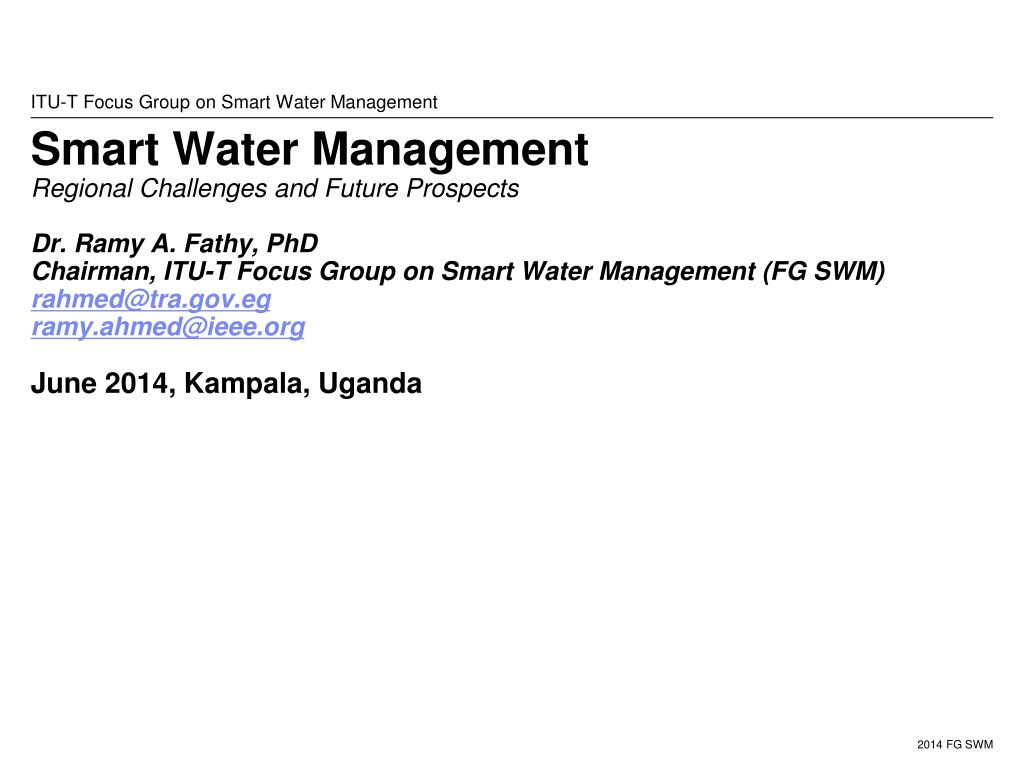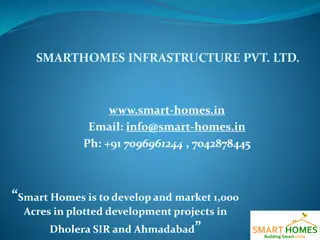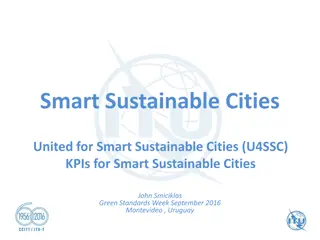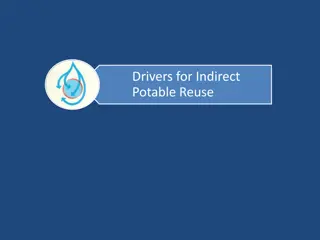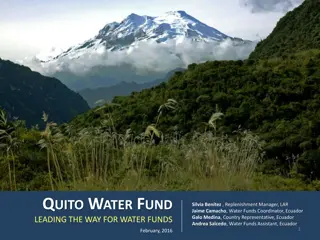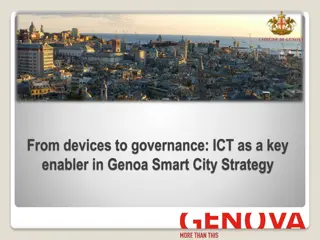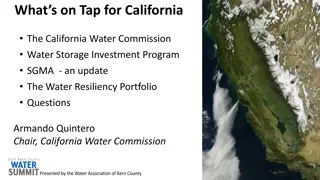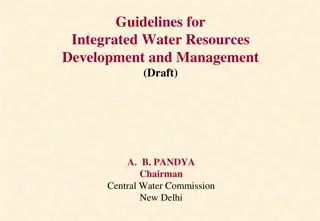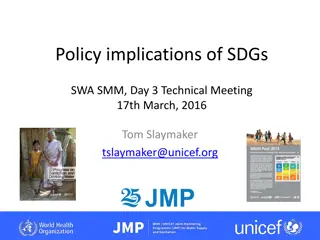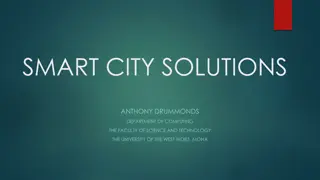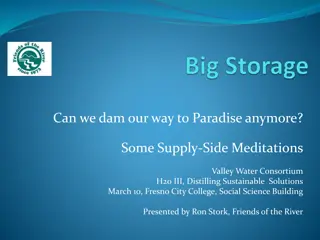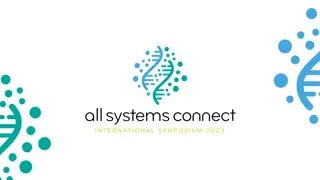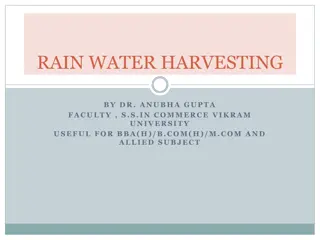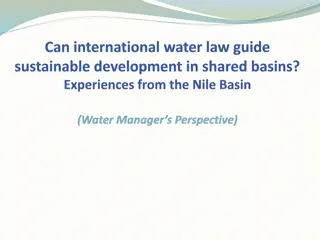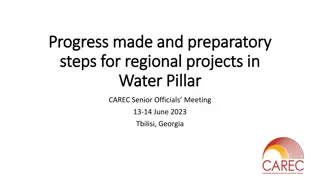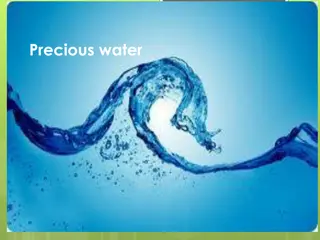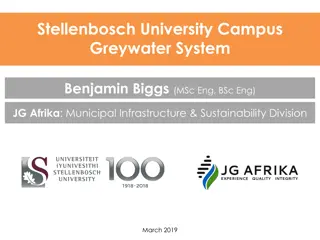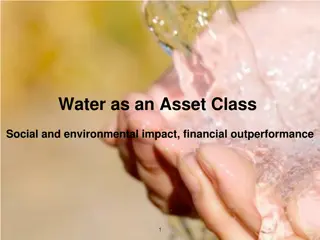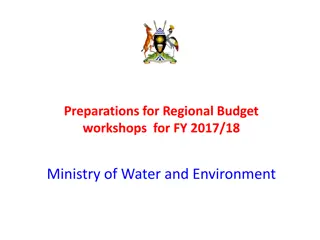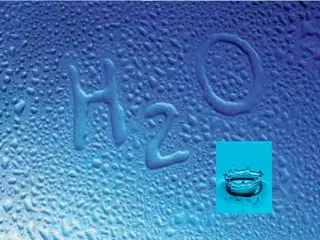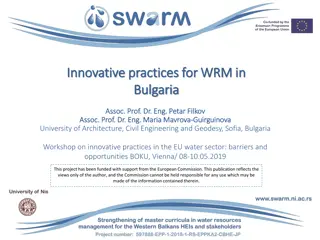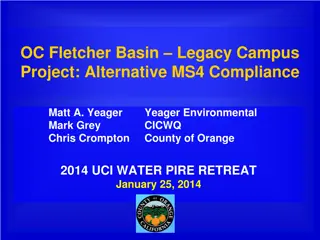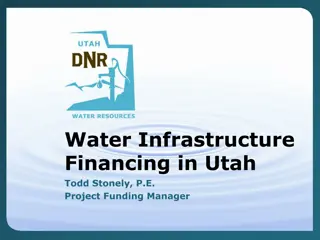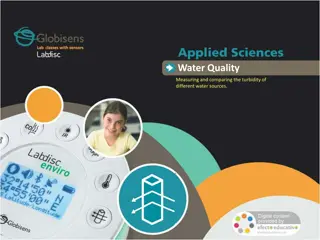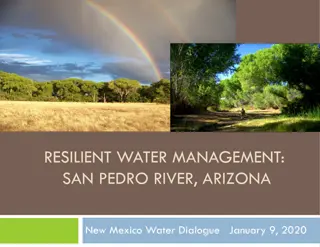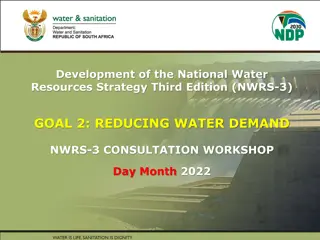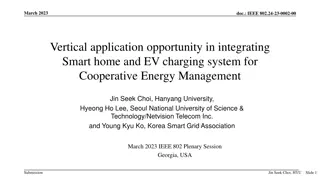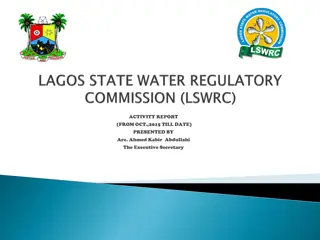Importance of Smart Water Management for Sustainable Development
Water is a vital resource crucial for life, development, and environmental sustainability. Effective management of water resources is essential to meet society's demands and promote economic growth. This focus group explores key global water challenges, stakeholder involvement, integrated smart water resource management, and the roadmap for smart water management implementation.
Download Presentation

Please find below an Image/Link to download the presentation.
The content on the website is provided AS IS for your information and personal use only. It may not be sold, licensed, or shared on other websites without obtaining consent from the author. Download presentation by click this link. If you encounter any issues during the download, it is possible that the publisher has removed the file from their server.
E N D
Presentation Transcript
ITU-T Focus Group on Smart Water Management Smart Water Management Regional Challenges and Future Prospects Dr. Ramy A. Fathy, PhD Chairman, ITU-T Focus Group on Smart Water Management (FG SWM) rahmed@tra.gov.eg ramy.ahmed@ieee.org June 2014, Kampala, Uganda 2014 FG SWM
ITU-T Focus Group on Smart Water Management Outline Water and Economic Development Key Global Water Challenges Water Utilities Stakeholders Challenges Integrated Smart Water Resource Management Roadmap of Smart Water Management Implementation 2 2014 FG SWM
ITU-T Focus Group on Smart Water Management Outline Water and Economic Development Key Global Water Challenges Water Utilities Stakeholders Challenges Integrated Smart Water Resource Management Roadmap of Smart Water Management Implementation 3 2014 FG SWM
ITU-T Focus Group on Smart Water Management Water is vital for life, development, and the sustainability of the environment! Water is a precious natural resource, vital for life, development and the environment. It can be a matter of life and death, depending on how it occurs and how it is managed. Abundance is a problem. Scarcity is a problem. A perfect balance that meets the society water demands, without exceeding the unmanageable threshold of water supplies is crucial for the effective management of the resources. Water can be an instrument for economic survival and growth. The vice versa is also true ! Inadequate water quantities or bad quality water can be a limiting factor in poverty alleviation and economic recovery, resulting in poor health and low productivity, food insecurity and constrained economic development. (Niyi Gbadegesin and Felix Olorunfemi, 2007) 4 2014 FG SWM
ITU-T Focus Group on Smart Water Management Water Availability and Economic Development: A Self Reinforcing Loop ! Low access to adequate water and sanitation High rate of communicable diseases Poverty Reduction in vitality & economic productivity 5 2014 FG SWM
ITU-T Focus Group on Smart Water Management Outline Water and Economic Development Key Global Water Challenges Water Utilities Stakeholders Challenges Integrated Smart Water Resource Management Roadmap of Smart Water Management Implementation 6 2014 FG SWM
ITU-T Focus Group on Smart Water Management Outline Water and Economic Development Key Global Water Challenges Water Utilities Stakeholders Challenges Integrated Smart Water Resource Management Roadmap of Smart Water Management Implementation 7 2014 FG SWM
ITU-T Focus Group on Smart Water Management The global water consumption exceeds the global population growth and distribution network inefficiencies are aggravating the problem. Predictions indicate increase in the world population, concentrating especially in urban areas and cities in the next twenty years Significant increases in the demand for potable water and waste water generation. Currently, water consumption doublesevery twenty years, more than double the rate of human population growth. Increased demand versus obsolete distribution networks. The influence of climate change which aggravates weather phenomena, affecting especially big cities. Flexible systems will be needed to adapt to these circumstances and provide resource management at critical times. 8 2014 FG SWM
ITU-T Focus Group on Smart Water Management One-fifth of the world's population lives under conditions of water scarcity 9 2014 FG SWM
ITU-T Focus Group on Smart Water Management More than 2.8 billion people from 48 countries will face water scarcity problems by 2025 10 2014 FG SWM
ITU-T Focus Group on Smart Water Management Physical versus economic scarcity Economic Water Scarcity A condition where there is not enough water to meet demand. Most arid regions often suffer from the lack of physical access to water resources. Mainly induced due to the lack of investment in water resource construction and management to meet the required water demand. No enough monetary means to obtain adequate and clean water. Physical Water Scarcity 11 2014 FG SWM
ITU-T Focus Group on Smart Water Management Nearly every region in the world suffers from areas with physical and/or economic water scarcity, with varying degrees. 12 2014 FG SWM
ITU-T Focus Group on Smart Water Management Nearly every region in the world suffers from areas with physical and/or economic water scarcity, with varying degrees. Approximately 700 million people in 43 countries suffer from water scarcity today. In 2025, 1.8 billion people will be living in countries with absolute water scarcity, and 67% of the global population could be living under water stressed situations. Under the existing climate change condition, almost 50% the global population will be living in areas of high water stress by 2030, with 75 to 250 million people in Africa. In some arid and semi-arid places between 24 and 700 million people will be displaced from their places. Sub Saharan Africa has the largest number of water stressed countries of any region (UNDESA, 2013). 13 2014 FG SWM
ITU-T Focus Group on Smart Water Management Water scarcity and access to basic water services is a global problem. Almost 89% (6.1 billion people) of the total global population have access to an improved water source in 2010. However, more than 780 million people, or one-tenth of the global population still relied on unimproved drinking water sources. 14 2014 FG SWM
ITU-T Focus Group on Smart Water Management Impact of climate change on water availability is crucial. The hydrological cycle is a continuous movement of water through precipitation and evaporation and all of the processes in between above and below the surface of the Earth. The increase in temperatures impact water cycle dramatically. The increase in temperature causes people, animals, and plants to consume more water in order to safeguard their lives. Moreover, many social and economic development activities, such as producing energy at power plants, raising livestock, and growing food crops also require more water. Amount of fresh water available for all of these activities may reduce as the Earth warms and as competition for water resources increases (USGCRP, 2009). 15 2014 FG SWM
ITU-T Focus Group on Smart Water Management The real future concern of the change in the rainfall pattern is the decrease of run-off water, which may affect large agricultural areas. Snow melting earlier in a year People, animals, & plants consume more water Increase in Temp Rain (rather than snow) Rate of Evapotrans Changes in water flow of rivers Scarcity and less availability of water Atmosphere capacity of holding water Excess precipitation 16 2014 FG SWM
ITU-T Focus Group on Smart Water Management climate change is expected to seriously affect the available water resource for arable regions in the next 40 years (e.g., Europe, United States, parts of Brazil, South Africa). 17 2014 FG SWM
ITU-T Focus Group on Smart Water Management Outline Water and Economic Development Key Global Water Challenges Water Utilities Stakeholders Challenges Integrated Smart Water Resource Management Roadmap of Smart Water Management Implementation 18 2014 FG SWM
ITU-T Focus Group on Smart Water Management Outline Water and Economic Development Key Global Water Challenges Water Utilities Stakeholders Challenges Integrated Smart Water Resource Management Roadmap of Smart Water Management Implementation 19 2014 FG SWM
ITU-T Focus Group on Smart Water Management The challenges of the water utilities stakeholders are multifaceted and complex and requires innovative cost effective solutions to address them. Institutional Constraints Aging Infrastructure ICT Gap Lack of Investment (15-20 Yrs. Return) Public Service Data Unavailability Lack of QoS 20 2014 FG SWM
ITU-T Focus Group on Smart Water Management Outline Water and Economic Development Key Global Water Challenges Water Utilities Stakeholders Challenges Integrated Smart Water Resource Management Roadmap of Smart Water Management Implementation 21 2014 FG SWM
ITU-T Focus Group on Smart Water Management Outline Water and Economic Development Key Global Water Challenges Water Utilities Stakeholders Challenges Integrated Smart Water Resource Management Roadmap of Smart Water Management Implementation 22 2014 FG SWM
ITU-T Focus Group on Smart Water Management Integrated Water Resource Management + Smart ICT Technologies Integrated Smart Water Resource Management (ISWM) IWRM is a process that promotes the coordinated development and management of water, land and related resources in order to maximize economic and social welfare in an equitable manner without compromising the sustainability of vital ecosystems. (Technical Committee of the Global Water Partnership) Focus on the knowledge and participation of all stakeholders and sectors involved We propose a slightly alternative definition that is foreseen to impact the targeted ISWM architecture. ISWM is a process that uses information and communication technologies and/or other means to realize the coordinated effective and efficient; management, development, and conservation of the water ecosystem in order to improve ecological and economic welfare in an equitable manner without compromising the sustainability of dependent ecosystems and stakeholders. 23 2014 FG SWM
ITU-T Focus Group on Smart Water Management ISWM Main Architectural Components Stakeholder Integrated Information System Stakeholder Dimension Modeling and Prediction Decision Support Systems ICT Infrastructure and Control Infrastructure Dimension 24 2014 FG SWM
ITU-T Focus Group on Smart Water Management ISWM Services and Sub-Systems Stakeholder Integrated Information Systems: The water ecosystem including utilities, municipalities, users have different uses and levels of water related information. Information systems centered on collaboration, and integration with well designed information security policies aids in minimizing costs, and maximizing efficiency in water use and environmental friendliness, both for industrial Automatic Meter Infrastructures (AMI), which allow automated and secured readings and improved communications between users and the central management, is one key enabling technology. Decision Support Systems (DSS): Are a fundamental aspect of modern ISWM which provides informed key decisions to water managers in critical situations. The DSS compiles data from Pollution and Water Quality Control, AMI, Weather Forecasting Systems, Modeling and Water Channel Behaviors, and much more to provide an intelligent cost effective decisions. Usually the geographical aspect is implemented by means of a Geographical Information System (GIS). Infrastructure Elements: Including the necessary module specific ICT for SWM, communications and information infrastructure. and domestic users. 25 2014 FG SWM
ITU-T Focus Group on Smart Water Management Information Infrastructure In the water sector, information system and knowledge management are recognized as important attributes for efficient and effective water works. GIS: technology that integrates hardware, software, and data required to capture, manage, analyse, and display all forms of geographically referenced information. GIS allows the user to view, visualize, question, interpret, and understand data in different circumstances that clarify patterns, trends, and relationships in the form of reports, maps, and charts. Source: http://www.onslowcountync.gov/assets/18981.jpg?langType=1033 26 2014 FG SWM
ITU-T Focus Group on Smart Water Management Communication Infrastructure Traditional water management systems mainly depends on protocols, industrial control systems, and adopted registered structures. Difficult to follow emerging communication trends very quickly. Opportunity to adopt an existing infrastructure into a more flexible IP-based monitoring system: alarm gathering, leakage detection and prevention, demand prediction, energy reduction, water quality monitoring, and billing activities. SCADA systems, advantageous for being highly distributed, are applied to control geographically distributed resources where centralized data acquisition and control are important to the system operation. It is the most common method currently applied in distribution systems, like water distribution and wastewater collection systems. The system control unit performs centralized monitoring, and control long distance communication network; including monitoring the status of data processing and alarms. The method can work using the combination of radio and direct-wired connection systems. The General Packet Radio Services (GPRS) and Global System for Mobile communication (GSM) are the common wireless technologies applied to cellular networks to be used as water metering infrastructure. Widely available, widely supported by many telecom operators and vendors, and low bandwidth requirement. 27 2014 FG SWM
ITU-T Focus Group on Smart Water Management Modeling, Prediction and DSS Hydrological models and DSS help water resource professionals, companies, and universities, local, regional, and governmental authorities, meteorological agencies, and other water sectors to effectively: manage, predict, and make proper decisions on the available water resource. Hydraulic model based simulation and optimization of water distribution network (WDN) was a trend of research during the last decades. Real-time processing of data from environmental instrumentation (whether they are in situ and from remote sensing) DSS helps solving decision-making problems in the management of water distribution network. Computer simulation based or indigenous knowledge based Heuristics and AI 28 2014 FG SWM
ITU-T Focus Group on Smart Water Management Smart Metering Meters and sensors are currently being intensively applied to regulate different activities of water distribution systems such as hydraulic pressure and flow, water quality, head losses, and water and energy consumptions. Convey prompt, reliable, and information-secured water metered information to avoid any potential damages, foresee expected disasters, detect leakages and provide accountability. Real-time decision making at the measurement and monitoring location. Improved data quality and overall consistency. Remote configuration capability. Flow Leak Detction Pressure Meters & Sensors Consumption Quality SCADA 29 2014 FG SWM
ITU-T Focus Group on Smart Water Management Water Supply and Irrigation Design and Management Adopted since the early fifties. Modern and advanced water supply plants in the developed countries are currently fully automatized. Different ICT tools are used to synchronize water supply with demand, regulate pump operations to save energy, manage the withdrawal of water from different sources and reservoirs, and control the purification processes in sewage recovery structures. ICT tools in agricultural development activities helps to improve the network and hydraulic design of irrigation systems. Possible elementary software applications include water head losses calculation during flowing water in pipes. Advanced software applications simulate the water flow in a complicated loop of water networks and facilitate optimization of pressure flow in irrigation systems. ICT tools help to facilitate computerized irrigation water budgeting system based on soil type and its water retention capacity, climatic condition, crop water requirements, soil moisture, and the plant water potential measurements. 30 2014 FG SWM
ITU-T Focus Group on Smart Water Management Pollution Control Increasing worldwide contamination of water sources with thousands of industrial and natural chemical compounds is one of the key environmental problems facing humanity. Approximately 3 billion people do not have access to safe drinking water, which is linked to over 35% of all deaths in developing countries. Water quality assessments are based on the analysis of the physical, chemical and bacteriological parameters and require customized apparatus and trained staff. Environmental water monitoring includes measurements of physical characteristics (e.g. pH, temperature, conductivity), chemical parameters (e.g. oxygen, alkalinity, nitrogen and phosphorus compounds), and abundance of certain biological taxa. Assays of biological activity could be included such as alkaline phosphatase, tests for toxins and direct measurements of pollutants such as heavy metals or hydrocarbons. Up to 70,000 known and emerging chemicals that might be present in various water resources, including for drinking water production. 860 active compounds are currently formulated in pesticide products. 31 2014 FG SWM
ITU-T Focus Group on Smart Water Management Pollution Control Lab based methods that require an effective management process Standard UV-Vis Measurements Mass Spectrometry Amperometric Sensors Traditional Methods Real Time Monitoring Methods Lab-on-chip Bio-sensors EM Sensors Using automated and situ methods 32 2014 FG SWM
ITU-T Focus Group on Smart Water Management Monitoring and Early Disaster Warning Systems Continuous rains, and short bursts of heavy rain, cause breaches of water courses and flooding of crossings Early warning systems involve four elements, which need to be supported by governance, coordination mechanisms from national to local levels, and by appropriate infrastructure. These four elements are: (1) Behavior Prediction and Modeling: Modeling the expected behavior of the water system with multiple degrees of freedom can provide case scenarios for possible disasters and expected impact. (2) Risk Assessment: Risk assessment provides an estimate of the probability of occurrence of an incident along with its expected impact. Priorities can be set to addressed highest probable events with maximum potential negative impact. (3) Warning Service: Constant monitoring of possible disaster precursors is necessary to generate prompt and reliable warnings on time. Integration of multiple data sources for consistency and fast data fusion is key to undertake a decision. (4) Communication and Dissemination: Clear warnings must reach relevant stakeholders in a fast and reliable way suitable to the incident at hand. Coordinated cross agencies communication and dissemination systems are key. 33 2014 FG SWM
ITU-T Focus Group on Smart Water Management Outline Water and Economic Development Key Global Water Challenges Water Utilities Stakeholders Challenges Integrated Smart Water Resource Management Roadmap of Smart Water Management Implementation 34 2014 FG SWM
ITU-T Focus Group on Smart Water Management Outline Water and Economic Development Key Global Water Challenges Water Utilities Stakeholders Challenges Integrated Smart Water Resource Management Roadmap of Smart Water Management Implementation 35 2014 FG SWM
ITU-T Focus Group on Smart Water Management Roadmap to ISWM How can governments and water authorities implement an ISWM? Develop and understanding to answer the following questions: How is decision taken in water management issues? By what procedures? How can the following aspects be insured? Fairness Transparency Effectiveness Mutual Value Public Engagement Environmental Sustainability What are the current available infrastructure and what are the currents limitations? The high-level Roadmap is as a four stage procedure: (1) The first is the developing a collaboration governance and decision-making framework. At this stage, the objectives of the ISWM and the KPI of performance are developed and agreed by the water management stakeholders. (2) The second stage in the development of the Information Infrastructure. (e.g. Databases, Maps, Knowledgebase ) At this stage the question of how much resources are available and who needs it is answered. 36 2014 FG SWM
ITU-T Focus Group on Smart Water Management Roadmap to SWM (3) The third stage is the development of the necessary communication and sector specific infrastructure after conducting the necessary cost-benefit analysis and value proposition. Case studies and means to satisfy the agreed KPI should be envisioned in the process. This stage takes into consideration all aspects priorities, and budgetary and other constraints. (4) The next stage is the implementation and monitoring stage, where institutional and capacity building, environmental sustainability are embedded in this stage. Assessment of the socio-economic and ecological impacts of the implemented system should be applied and evaluated for further process feedback. 37 2014 FG SWM
ITU-T Focus Group on Smart Water Management References Focus Group on Smart Water Management (FG SWM): http://www.itu.int/en/ITU- T/focusgroups/swm/Pages/default.aspx Draft deliverable on The Role of ICT in Water Resource Management , Ramy A Fathy, and Solomon Hailu, SWM-o-0007. Niyi Gbadegesin and Felix Olorunfemi, Assessment of Rural Water Supply Management in Selected Rural Areas of Oyo State, Nigeria, ATPS Working Paper Series No. 49, 2007. 38 2014 FG SWM
ITU-T Focus Group on Smart Water Management Thank You 39 2014 FG SWM
